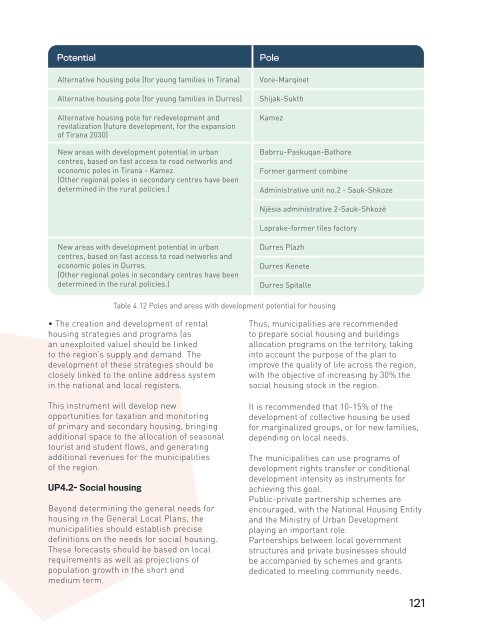Integrated Cross-Sectorial Plan of Tirana-Durres Area
The Albanian Government and the National Spatial Plan have identified the Tiranë-Durrës area, as one of the most important economic areas of the country, and of the Balkan region. To ensure a sustainable territorial and urban development of this area, the Ministry of Urban Development in cooperation with the National Territorial Planning Agency has taken the initiative to draft a Cross-sectoral Integrated Plan for the economic area Tiranë – Durrës. The metropolitan region under study includes territories administered by 5 municipalities: Tiranë, Durrës, Vorë, Shijak, Kamëz.
The Albanian Government and the National Spatial Plan have identified the Tiranë-Durrës area, as one of the most important economic areas of the country, and of the Balkan region. To ensure a sustainable territorial and urban development of this area, the Ministry of Urban Development in cooperation with the National Territorial Planning Agency has taken the initiative to draft a Cross-sectoral Integrated Plan for the economic area Tiranë – Durrës. The metropolitan region under study includes territories administered by 5 municipalities: Tiranë, Durrës, Vorë, Shijak, Kamëz.
You also want an ePaper? Increase the reach of your titles
YUMPU automatically turns print PDFs into web optimized ePapers that Google loves.
Potential<br />
Alternative housing pole (for young families in <strong>Tirana</strong>)<br />
Alternative housing pole (for young families in <strong>Durres</strong>)<br />
Alternative housing pole for redevelopment and<br />
revitalization (future development, for the expansion<br />
<strong>of</strong> <strong>Tirana</strong> 2030)<br />
New areas with development potential in urban<br />
centres, based on fast access to road networks and<br />
economic poles in <strong>Tirana</strong> - Kamez.<br />
(Other regional poles in secondary centres have been<br />
determined in the rural policies.)<br />
Pole<br />
Vore-Marqinet<br />
Shijak-Sukth<br />
Kamez<br />
Babrru-Paskuqan-Bathore<br />
Former garment combine<br />
Administrative unit no.2 - Sauk-Shkoze<br />
Njësia administrative 2-Sauk-Shkozë<br />
Laprake-former tiles factory<br />
New areas with development potential in urban<br />
centres, based on fast access to road networks and<br />
economic poles in <strong>Durres</strong>.<br />
(Other regional poles in secondary centres have been<br />
determined in the rural policies.)<br />
<strong>Durres</strong> Plazh<br />
<strong>Durres</strong> Kenete<br />
<strong>Durres</strong> Spitalle<br />
Table 4.12 Poles and areas with development potential for housing<br />
• The creation and development <strong>of</strong> rental<br />
housing strategies and programs (as<br />
an unexploited value) should be linked<br />
to the region’s supply and demand. The<br />
development <strong>of</strong> these strategies should be<br />
closely linked to the online address system<br />
in the national and local registers.<br />
This instrument will develop new<br />
opportunities for taxation and monitoring<br />
<strong>of</strong> primary and secondary housing, bringing<br />
additional space to the allocation <strong>of</strong> seasonal<br />
tourist and student flows, and generating<br />
additional revenues for the municipalities<br />
<strong>of</strong> the region.<br />
UP4.2- Social housing<br />
Beyond determining the general needs for<br />
housing in the General Local <strong>Plan</strong>s, the<br />
municipalities should establish precise<br />
definitions on the needs for social housing.<br />
These forecasts should be based on local<br />
requirements as well as projections <strong>of</strong><br />
population growth in the short and<br />
medium term.<br />
Thus, municipalities are recommended<br />
to prepare social housing and buildings<br />
allocation programs on the territory, taking<br />
into account the purpose <strong>of</strong> the plan to<br />
improve the quality <strong>of</strong> life across the region,<br />
with the objective <strong>of</strong> increasing by 30% the<br />
social housing stock in the region.<br />
It is recommended that 10-15% <strong>of</strong> the<br />
development <strong>of</strong> collective housing be used<br />
for marginalized groups, or for new families,<br />
depending on local needs.<br />
The municipalities can use programs <strong>of</strong><br />
development rights transfer or conditional<br />
development intensity as instruments for<br />
achieving this goal.<br />
Public-private partnership schemes are<br />
encouraged, with the National Housing Entity<br />
and the Ministry <strong>of</strong> Urban Development<br />
playing an important role.<br />
Partnerships between local government<br />
structures and private businesses should<br />
be accompanied by schemes and grants<br />
dedicated to meeting community needs.<br />
121
















